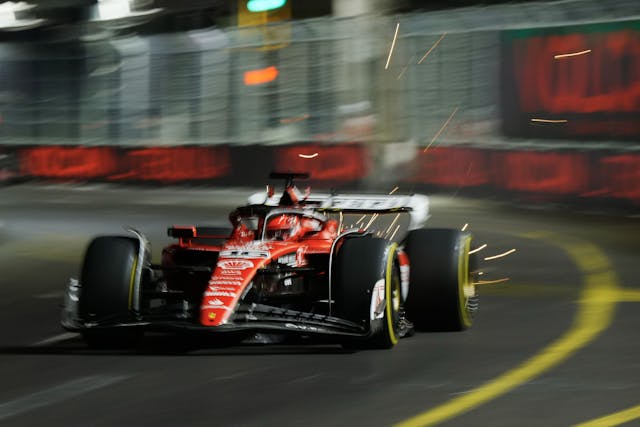What Will F1 Look Like in 2026? Here’s Your Answer
We’ve known for quite some time that Formula 1 is changing the rules, beginning in 2026. The cars themselves, as well as the engines, will be significantly different, and now we have the answer to just how different the F1 future will be.
Formula 1 has released many of the details, condensed into this 15-minute, 48-second video. In short, says F1, the cars will be “lighter, safer and more competitive!” That’s part of the caption on the video, titled “The Future of F1.”
You’ll also hear “more nimble” several times in the presentation, as well as multiple references regarding the new car’s ability to close up behind another car, something “dirty air,” generated by the lead car’s extensive aerodynamics, prevents in the 2024 F1 field of cars. You’ll also hear “more sustainable,” including the use of renewable fuel and an increased reliance on hybrid electric power.
These 2026 rules are set to be approved on June 28 by the FIA World Motor Sport Council. None of it comes as a surprise to the teams, the manufacturers, or the powertrain suppliers, as they have been kept in the loop, and have even run some of the proposed configurations on their simulators.
The FIA is estimating that the new car’s less-aggressive aerodynamics will reduce downforce by 30 percent, which is expected to reduce cornering speeds. But a 55 percent reduction in drag will mean higher straightaway speeds. Both front and rear wings will be cockpit-adjustable.
Pirelli, the tire manufacturer, will make the tires narrower by 25mm (almost one inch) in front, and 30mm (1.18 inches) in the rear. The cars will still use 18-inch wheels.
The new cars will be about 66 pounds lighter, with a wheelbase nearly eight inches shorter and a width about four inches narrower. Replacing the DRS (drag reduction system) on current cars is a “manual override” that will provide more electrical boost to a following car. F1 has been stung by complaints that there isn’t enough passing, and they are seeking to change that for 2026.
The cars will still be hybrids, with a far greater concentration on the electric aspect. The internal combustion engine will still be a 1.6-liter turbocharged V-6, though its power will be reduced, while the electrical end of the power unit will be increased by about 300 percent. F1 claims a record six future “power unit” suppliers—Ferrari, Mercedes, Renault, Honda, Ford and Audi. No mention of Cadillac, which hopes to power the proposed Andretti entry.
While the cars will be smaller and lighter, F1 says they’ll be safer, too. The rollover hoop has been strengthened, and the new nose will be recast as a two-piece unit, with the forward piece designed to give way in the event of a collision, while the second piece will still offer protection in the event of a subsequent impact.
“The key features of the 2026 F1 Regulations are advanced sustainability, technology, and safety,” said FIA President Mohammed Ben Sulayem. “Our aim, together with Formula 1, was to produce a car that was right for the future of the sport’s elite category. We believe we have achieved that goal.”
We’ll see.
***
Check out the Hagerty Media homepage so you don’t miss a single story, or better yet, bookmark it. To get our best stories delivered right to your inbox, subscribe to our newsletters.



And the new cars will still be utterly unable to turn Monte Carlo into an actual race.
This video is rather long and redundant. The cars will be smaller, lighter, put more emphasize on electric , driver controls and … yatta yatta yatta . Yea I got it all two minutes ago. My guess, given, would be that everyone is scrambling for engineers that have a firm hand on mechanical grip now. We will see. ” Oh Canada! ” qualifying was interesting to say the least. I still always pull for Williams, so not a bad day.
I’m expecting to be bored. I’ve stopped watching races.
I’m with Gary, although I have to admit that I enjoyed the race from Canada…until the fairly inevitable end.
A major step backwards for race car engineering. Lighter weight is usually a plus, but lower aero drag will mean slower speeds in the turns. I predict more cars leaving the track, and more collisions. Why not let each team’s engineers design the cars? Isn’t that a major part of the manufacturer trophy presentation?
Doug – While on spec it does seem like F-1 is ” juicing the ball ” because most fans like seeing home runs, there does have to be some limitations on what is allowed. F-1 banned Carbotanium ( yes, that is a real thing for those who don’t know ) because only the highest budgeted teams would be able to use it and the rest hung out to dry. At one time the fuel mix that F-1 cars could use was called ‘ witches brew ‘ because it was so volatile it was scary. I love the ‘here’s the rule book, as long as your not breaking them, knock yourselves out ‘ days too. But the tech has advanced so much that the difference between a podium car and an also ran comes to subtle differences in design that when combined determine the outcome. It’s still interesting to me to hear before the race that this team has brought a new front wing or..and it may often be the small bit they needed to get up in the top five. To look at it you’d never know but… F-1, to me, is one of the best examples of -‘ the devil is in the details’ .